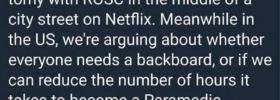Well, it’s once again EMS Week. Or to everyone else in healthcare who’s not an EMT or a paramedic (and yes, there’s a BIG honking difference), it’s Ambulance Driver Week.
And for most hospitals, that means y’all will feed us (don’t forget we’re a 24 hour operation) presuming the staff doesn’t graze over our meals as well and/or give us swag festooned with your hospital logo all over it. Don’t get me wrong. I love food. I love cold drinks. I can always use an extra pen or pair of shears. And I love the EMS room at a lot of the hospitals I’ve been to. Sometimes, that snack is all that’s keeping me, your facility, and our patients from me getting hangry.
But there’s more I’d appreciate from the hospitals, nurses, and doctors. Every year, during EMS Week, we hear how we’re your “valued partners in healthcare.” Valued partners get real recognition and partnership every week of the year, every day of the week. And there’s at least some of us who would like more of a partnership than a week with a taco bar or a regularly stocked EMS room. (Like I said, I won’t turn away food.)
But a real partnership means more than that. A real partnership means including us in education. I’ve lost count of how many colleagues in EMS education tell me about hospitals turning down EMS education programs’ requests for their hospital to be a site for clinical rotations. Those sites that do remain know they have EMS educators at their mercy and such clinical agreements have become something that it takes a lawyer to review, read, and understand. (Fortunately, I know an attorney who can do this.) Further, these clinical site agreements now have more and more restrictions on them, specifically now requiring the EMS education program to send a paid preceptor to supervise the students. A real partnership with EMS means allowing EMS students to “do things.” Labor and delivery rotations shouldn’t be “observation only,” especially when nursing staff loudly asks the mother “You don’t want a male EMT/paramedic student in here, do you?” Clinical shifts should be more than “observation or basic life support only” for paramedic students. I am tired of hearing pediatric facilities complain about their perception of EMS providers being weak at pediatrics when they won’t allow EMS students into their facilities or severely limit their participation as they tell us, “All you need to know is to bring the kid here. WE are the pediatric experts.” (And don’t get me started about a certain Houston pediatric hospital mandating that EMS get vital signs on the hospital’s blood pressure monitor as opposed to accepting EMS obtained vital signs.) And for the doctors who say that paramedics shouldn’t intubate or do other low frequency, high acuity skills, when will you allow EMS students as well as current providers the opportunity to get into the operating room to intubate or to shadow you?
There absolutely are EMS providers who are as passionate about professional development, growth, and excellence as anyone on the other side of the hospital doors. There are also those of us who pencil whip continuing education and have to be dragged kicking and screaming to accept changes in medicine. There are similar providers inside the hospital as well. I can usually recognize these folks when they refer to oxygen saturation as “O Two Stats.” But for those of us who want to learn, make these opportunities available to EMS. At least some of us will attend.
If we’re truly partners in healthcare, treat us as such. Allow this partnership to benefit our collective patient population. And if the altruism doesn’t convince you, consider this. I did my EMT rotations all at one hospital. I did all of my paramedic rotations in the emergency department and intensive care department at the larger hospital in the same network. My family has used that hospital network virtually exclusively since I obtained my EMS certifications. I have recommended this network and their physicians to many other friends. If nothing else, this hospital network opening their doors to a student has paid off many times to the network and their associated physicians, bringing them patients (and revenue) they would have never seen otherwise.
I truly do love the hospitals, nurses, and physicians that I get to work with regularly. I don’t expect tokens of thanks. I won’t turn down a cold drink or a snack. But the education and collaboration would be a special treat on EMS Week and every other week.
